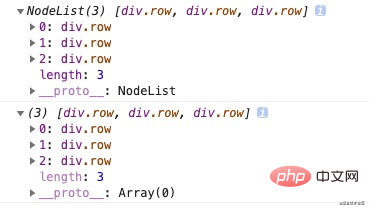Understand the ES6 spread operator and talk about 8 ways to use it
This article takes you through the expansion operators in ES6 and introduces 8 ways to use the ES6 expansion operators.

Expand operator… is introduced in ES6, which expands the iterable object into its separate elements. The so-called iterable object is any Objects that can be traversed using a for of loop, such as: Array, String, Map, Set , DOM nodes, etc.
1. Copy array objects
Using the expansion operator to copy an array is a common operation in ES6:
const years = [2018, 2019, 2020, 2021]; const copyYears = [...years]; console.log(copyYears); // [ 2018, 2019, 2020, 2021 ]
The expansion operator copies an array, onlyThe first layer is deep copy, that is, using the spread operator to copy a one-dimensional array is a deep copy. See the following code:
const miniCalendar = [2021, [1, 2, 3, 4, 5, 6, 7], 1]; const copyArray = [...miniCalendar]; console.log(copyArray); // [ 2021, [ 1, 2, 3, 4, 5, 6, 7 ], 1 ] copyArray[1][0] = 0; copyArray[1].push(8); copyArray[2] = 2; console.log(copyArray); // [ 2021, [ 0, 2, 3, 4, 5, 6, 7, 8 ], 2 ] console.log(miniCalendar); // [ 2021, [ 0, 2, 3, 4, 5, 6, 7, 8 ], 1 ]
Put the printed results together to make it clearer. The comparison is as follows:
| Variable description | Result | Operation |
|---|---|---|
copyArray | [ 2021, [ 1, 2, 3, 4, 5, 6, 7 ], 1 ] | Copy ArrayminiCalendar |
##copyArray | [ 2021, [ 0, 2, 3, 4, 5, 6, 7, 8 ], 2 ] | 1. Reassign the first element of the second element of the array to 0; 2. Add an element 8 to the second element of the array; 3. Reassign the third element of the array to 2|
miniCalendar | [ 2021, [ 0, 2, 3, 4, 5, 6, 7, 8 ], 1 ] | From the results, the second element of the array is an array, which is larger than 1 dimension. Changes to the elements inside will cause the original variable to The value changes accordingly
const time = {
year: 2021,
month: 7,
day: {
value: 1,
},
};
const copyTime = { ...time };
console.log(copyTime); // { year: 2021, month: 7, day: { value: 1 } }copyTime.day.value = 2;
copyTime.month = 6;
console.log(copyTime); // { year: 2021, month: 6, day: { value: 2 } }
console.log(time); // { year: 2021, month: 7, day: { value: 2 } }Strictly speaking, the spread operator does not perform deep copy
2. Merge operation
Let’s first look at the array Merge, as follows:const halfMonths1 = [1, 2, 3, 4, 5, 6]; const halfMonths2 = [7, 8, 9, 10, 11, 12]; const allMonths = [...halfMonths1, ...halfMonths2]; console.log(allMonths); // [ 1, 2, 3, 4, 5, 6, 7, 8, 9, 10, 11, 12 ]
const time1 = {
month: 7,
day: {
value: 1,
},
};
const time2 = {
year: 2021,
month: 8,
day: {
value: 10,
},
};
const time = { ...time1, ...time2 };
console.log(time); // { month: 8, day: { value: 10 }, year: 2021 }3. Parameter passingconst sum = (num1, num2) => num1 + num2;
console.log(sum(...[6, 7])); // 13
console.log(sum(...[6, 7, 8])); // 13
Copy after login
From the above code, we can see that the number of parameters passed in by the expansion operator is the same as the number of parameters defined by the function. is used together with the const sum = (num1, num2) => num1 + num2; console.log(sum(...[6, 7])); // 13 console.log(sum(...[6, 7, 8])); // 13
math function, as follows:
const arrayNumbers = [1, 5, 9, 3, 5, 7, 10]; const min = Math.min(...arrayNumbers); const max = Math.max(...arrayNumbers); console.log(min); // 1 console.log(max); // 10
4. Array deduplication
andSet Use together to eliminate duplicates in the array, as follows:
const arrayNumbers = [1, 5, 9, 3, 5, 7, 10, 4, 5, 2, 5]; const newNumbers = [...new Set(arrayNumbers)]; console.log(newNumbers); // [ 1, 5, 9, 3, 7, 10, 4, 2 ]
5. String to character array
String is also an iterable object , so you can also use the expansion operator ... to convert it into a character array, as follows:
const title = "china"; const charts = [...title]; console.log(charts); // [ 'c', 'h', 'i', 'n', 'a' ]
const title = "china";
const short = [...title];
short.length = 2;
console.log(short.join("")); // ch6. NodeList Convert to array
NodeList
The object is a collection of nodes, usually composed of attributes, such asNode. childNodesand methods such asdocument.querySelectorAllreturn.
NodeList is similar to an array, but not an array. It does not have all the methods of Array, such as find, map, filter, etc., but can be iterated using forEach().
const nodeList = document.querySelectorAll(".row");
const nodeArray = [...nodeList];
console.log(nodeList);
console.log(nodeArray);
7. Destructuring variables
Destructuring the array, as follows:const [currentMonth, ...others] = [7, 8, 9, 10, 11, 12]; console.log(currentMonth); // 7 console.log(others); // [ 8, 9, 10, 11, 12 ]
const userInfo = { name: "Crayon", province: "Guangdong", city: "Shenzhen" };
const { name, ...location } = userInfo;
console.log(name); // Crayon
console.log(location); // { province: 'Guangdong', city: 'Shenzhen' }8. Print log
When printing iterable objects, you need You can use expansion operators to print each item, as follows:const years = [2018, 2019, 2020, 2021]; console.log(...years); // 2018 2019 2020 2021
Summary
Extension operators… Make the code concise, it should be ES6 The most popular operator among them.
This article is reproduced from: https://juejin.cn/post/6979840705921286180For more programming-related knowledge, please visit:
Introduction to Programming ! !
The above is the detailed content of Understand the ES6 spread operator and talk about 8 ways to use it. For more information, please follow other related articles on the PHP Chinese website!

Hot AI Tools

Undresser.AI Undress
AI-powered app for creating realistic nude photos

AI Clothes Remover
Online AI tool for removing clothes from photos.

Undress AI Tool
Undress images for free

Clothoff.io
AI clothes remover

Video Face Swap
Swap faces in any video effortlessly with our completely free AI face swap tool!

Hot Article

Hot Tools

Notepad++7.3.1
Easy-to-use and free code editor

SublimeText3 Chinese version
Chinese version, very easy to use

Zend Studio 13.0.1
Powerful PHP integrated development environment

Dreamweaver CS6
Visual web development tools

SublimeText3 Mac version
God-level code editing software (SublimeText3)

Hot Topics
 How to reverse an array in ES6
Oct 26, 2022 pm 06:19 PM
How to reverse an array in ES6
Oct 26, 2022 pm 06:19 PM
In ES6, you can use the reverse() method of the array object to achieve array reversal. This method is used to reverse the order of the elements in the array, putting the last element first and the first element last. The syntax "array.reverse()". The reverse() method will modify the original array. If you do not want to modify it, you need to use it with the expansion operator "...", and the syntax is "[...array].reverse()".
 Is async for es6 or es7?
Jan 29, 2023 pm 05:36 PM
Is async for es6 or es7?
Jan 29, 2023 pm 05:36 PM
async is es7. async and await are new additions to ES7 and are solutions for asynchronous operations; async/await can be said to be syntactic sugar for co modules and generator functions, solving js asynchronous code with clearer semantics. As the name suggests, async means "asynchronous". Async is used to declare that a function is asynchronous; there is a strict rule between async and await. Both cannot be separated from each other, and await can only be written in async functions.
 Why does the mini program need to convert es6 to es5?
Nov 21, 2022 pm 06:15 PM
Why does the mini program need to convert es6 to es5?
Nov 21, 2022 pm 06:15 PM
For browser compatibility. As a new specification for JS, ES6 adds a lot of new syntax and API. However, modern browsers do not have high support for the new features of ES6, so ES6 code needs to be converted to ES5 code. In the WeChat web developer tools, babel is used by default to convert the developer's ES6 syntax code into ES5 code that is well supported by all three terminals, helping developers solve development problems caused by different environments; only in the project Just configure and check the "ES6 to ES5" option.
 How to find different items in two arrays in es6
Nov 01, 2022 pm 06:07 PM
How to find different items in two arrays in es6
Nov 01, 2022 pm 06:07 PM
Steps: 1. Convert the two arrays to set types respectively, with the syntax "newA=new Set(a);newB=new Set(b);"; 2. Use has() and filter() to find the difference set, with the syntax " new Set([...newA].filter(x =>!newB.has(x)))", the difference set elements will be included in a set collection and returned; 3. Use Array.from to convert the set into an array Type, syntax "Array.from(collection)".
 How to implement array deduplication in es5 and es6
Jan 16, 2023 pm 05:09 PM
How to implement array deduplication in es5 and es6
Jan 16, 2023 pm 05:09 PM
In es5, you can use the for statement and indexOf() function to achieve array deduplication. The syntax "for(i=0;i<array length;i++){a=newArr.indexOf(arr[i]);if(a== -1){...}}". In es6, you can use the spread operator, Array.from() and Set to remove duplication; you need to first convert the array into a Set object to remove duplication, and then use the spread operator or the Array.from() function to convert the Set object back to an array. Just group.
 What does es6 temporary Zenless Zone Zero mean?
Jan 03, 2023 pm 03:56 PM
What does es6 temporary Zenless Zone Zero mean?
Jan 03, 2023 pm 03:56 PM
In es6, the temporary dead zone is a syntax error, which refers to the let and const commands that make the block form a closed scope. Within a code block, before a variable is declared using the let/const command, the variable is unavailable and belongs to the variable's "dead zone" before the variable is declared; this is syntactically called a "temporary dead zone". ES6 stipulates that variable promotion does not occur in temporary dead zones and let and const statements, mainly to reduce runtime errors and prevent the variable from being used before it is declared, resulting in unexpected behavior.
 Is require an es6 syntax?
Oct 21, 2022 pm 04:09 PM
Is require an es6 syntax?
Oct 21, 2022 pm 04:09 PM
No, require is the modular syntax of the CommonJS specification; and the modular syntax of the es6 specification is import. require is loaded at runtime, and import is loaded at compile time; require can be written anywhere in the code, import can only be written at the top of the file and cannot be used in conditional statements or function scopes; module attributes are introduced only when require is run. Therefore, the performance is relatively low. The properties of the module introduced during import compilation have slightly higher performance.
 How to determine how many items there are in an array in es6
Jan 18, 2023 pm 07:22 PM
How to determine how many items there are in an array in es6
Jan 18, 2023 pm 07:22 PM
In ES6, you can use the length attribute of the array object to determine how many items there are in the array, that is, to get the number of elements in the array; this attribute can return the number of elements in the array, just use the "array.length" statement. Returns a value representing the number of elements of the array object, that is, the length value.






